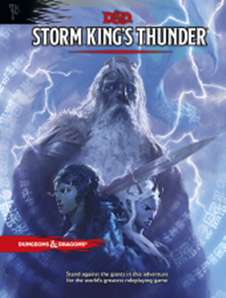 As most of you are likely aware, Storm King’s Thunder¸ the latest adventure from Chris Perkins and Wizards of the Coast, is now available in stores. It’s an adventure for 1st-10th level characters which sees them facing off against a lot of giants.
As most of you are likely aware, Storm King’s Thunder¸ the latest adventure from Chris Perkins and Wizards of the Coast, is now available in stores. It’s an adventure for 1st-10th level characters which sees them facing off against a lot of giants.
It is also, in a lot of ways, the companion to the Sword Coast Adventurer’s Guide. Your players have read that book? Good. They’ll then be able to visit many of the places in it during the course of the adventure. In any adventure where you visit a lot of places, it’s nice to actually know something about them in advance.
The adventure is very fascinating when you examine its structure. While Curse of Strahd felt very much like a sandbox adventure, as did – to varying extents – Princes of the Apocalypse and Out of the Abyss, the new adventure has a more linear and structured flow… but in its own way.
It also demonstrates one of the chief benefits from designing for an audience of millions. You can design stuff that some groups won’t use – because lots of other groups will use it! This is a far cry from designing for home games, where time spent on adventure design for adventures the players don’t go on is time that could have been better employed elsewhere.
So, what does SKT do?
It has an introductory adventure that covers levels 1-4. Its purpose? Introduce a few themes and get the players to level 5 as quickly as possible. Or, players could bring in level 5 characters from another adventure, like Lost Mine of Phandelver. Yes, that works too.
It then allows the DM to choose one of three towns that are threatened by the giants. The players only go to one of them, not all three, and thus the challenge will be different for different groups. This is level 5.
After the town the adventurers went to is saved, then a bunch of new quests are offered to the players, and we get the “sandbox” section, where the players attempt to complete small quests while wandering around the wilderness and getting a feel for the land they need to save. This is level 6. (Chapter 4 of the adventure, which covers this information, is also the DM’s notes to the information presented in the Sword Coast Adventurer’s Guide.) The quests they are given are different depending on which town they started in and who they befriended.
Eventually, the players run out of quests and the DM starts up the main plot of the adventure by not-so-subtly sending them a guide to get them to the next section: a visit to a giant temple where they learn who they actually have to confront to end the threat. This is level 7.
To reach their final goal, they need to pick up an item to reach there. The players have a choice of what giants they want to face to get that item: Hill, Stone, Frost, Fire or Cloud. This is level 8, and is the second time a significant section of the adventure will be different depending on their choice. There are 64 pages of the adventure devoted to describing the lairs – that’s a lot of design, a lot which won’t be used in one play-through.
So, the players reach their goal, and at some point may go on another quest before finally defeating the overall villain. That’s levels 9 and 10. And the adventure ends with, hopefully, the players victorious!
And, as a devotee of adventure design, this is an absolutely fascinating structure. It’s structured – there is a well-defined progression of encounters – but the path taken through it will be different for each group. At a gross level, there are 15 major variations as to how the adventure progresses, with additional various occurring during the wilderness trek depending on choices made during the defense of the beleaguered town. Some sections may run similarly – particularly the ending – but a group could quite easily play the adventure three times and get a lot of new content each time.
This is an exemplary example of good adventure design. I feel that the one-book model makes it far more feasible (imagine trying to do this in a six-volume Pathfinder Adventure Path!)
It’s also worth noting that at all times the players have goals: there are tasks they need to accomplish. They aren’t set loose in the wilderness with nothing to do. The adventure always gives them a direction, but mostly allows them to choose how to accomplish it.
I’m used to adventures that are linear: you visit each location in order. I’m used to adventures that are sandboxes: you visit locations in the order that pleases you, and might not visit them all. I’m not used to adventures that have large sections of content that won’t be used on one play through because the design excludes the use of certain sections based on a structured path.
This is fascinating, incredible stuff. If you get a chance to DM or play Storm King’s Thunder, take it. And then play it again, and discover how the second run differs.

what about these complaints about the hooks and motivations?
http://ragingowlbear.blogspot.com.br/2016/09/dnd-5e-storm-kings-thunder.html